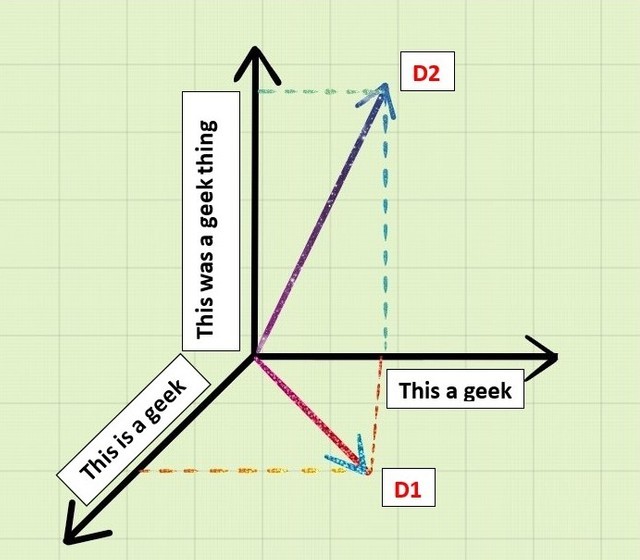Measuring the Document Similarity in Python
Last Updated :
27 Feb, 2020
Document similarity, as the name suggests determines how similar are the two given documents. By “documents”, we mean a collection of strings. For example, an essay or a .txt file. Many organizations use this principle of document similarity to check plagiarism. It is also used by many exams conducting institutions to check if a student cheated from the other. Therefore, it is very important as well as interesting to know how all of this works.

Document similarity is calculated by calculating document distance. Document distance is a concept where words(documents) are treated as vectors and is calculated as the angle between two given document vectors. Document vectors are the frequency of occurrences of words in a given document. Let’s see an example:
Say that we are given two documents D1 and D2 as:
D1: “This is a geek”
D2: “This was a geek thing”
The similar words in both these documents then become:
"This a geek"
If we make a 3-D representation of this as vectors by taking D1, D2 and similar words in 3 axis geometry, then we get:

Now if we take dot product of D1 and D2,
D1.D2 = "This"."This"+"is"."was"+"a"."a"+"geek"."geek"+"thing".0
D1.D2 = 1+0+1+1+0
D1.D2 = 3
Now that we know how to calculate the dot product of these documents, we can now calculate the angle between the document vectors:
cos d = D1.D2/|D1||D2|
Here d is the document distance. It’s value ranges from 0 degree to 90 degrees. Where 0 degree means the two documents are exactly identical and 90 degrees indicate that the two documents are very different.
Now that we know about document similarity and document distance, let’s look at a Python program to calculate the same:
Document similarity program :
Our algorithm to confirm document similarity will consist of three fundamental steps:
- Split the documents in words.
- Compute the word frequencies.
- Calculate the dot product of the document vectors.
For the first step, we will first use the .read() method to open and read the content of the files. As we read the contents, we will split them into a list. Next, we will calculate the word frequency list of the read in the file. Therefore, the occurrence of each word is counted and the list is sorted alphabetically.
import math
import string
import sys
def read_file(filename):
try:
with open(filename, 'r') as f:
data = f.read()
return data
except IOError:
print("Error opening or reading input file: ", filename)
sys.exit()
translation_table = str.maketrans(string.punctuation+string.ascii_uppercase,
" "*len(string.punctuation)+string.ascii_lowercase)
def get_words_from_line_list(text):
text = text.translate(translation_table)
word_list = text.split()
return word_list
|
Now that we have the word list, we will now calculate the frequency of occurrences of the words.
def count_frequency(word_list):
D = {}
for new_word in word_list:
if new_word in D:
D[new_word] = D[new_word] + 1
else:
D[new_word] = 1
return D
def word_frequencies_for_file(filename):
line_list = read_file(filename)
word_list = get_words_from_line_list(line_list)
freq_mapping = count_frequency(word_list)
print("File", filename, ":", )
print(len(line_list), "lines, ", )
print(len(word_list), "words, ", )
print(len(freq_mapping), "distinct words")
return freq_mapping
|
Lastly, we will calculate the dot product to give the document distance.
def dotProduct(D1, D2):
Sum = 0.0
for key in D1:
if key in D2:
Sum += (D1[key] * D2[key])
return Sum
def vector_angle(D1, D2):
numerator = dotProduct(D1, D2)
denominator = math.sqrt(dotProduct(D1, D1)*dotProduct(D2, D2))
return math.acos(numerator / denominator)
|
That’s all! Time to see the document similarity function:
def documentSimilarity(filename_1, filename_2):
sorted_word_list_1 = word_frequencies_for_file(filename_1)
sorted_word_list_2 = word_frequencies_for_file(filename_2)
distance = vector_angle(sorted_word_list_1, sorted_word_list_2)
print("The distance between the documents is: % 0.6f (radians)"% distance)
|
Here is the full sourcecode.
import math
import string
import sys
def read_file(filename):
try:
with open(filename, 'r') as f:
data = f.read()
return data
except IOError:
print("Error opening or reading input file: ", filename)
sys.exit()
translation_table = str.maketrans(string.punctuation+string.ascii_uppercase,
" "*len(string.punctuation)+string.ascii_lowercase)
def get_words_from_line_list(text):
text = text.translate(translation_table)
word_list = text.split()
return word_list
def count_frequency(word_list):
D = {}
for new_word in word_list:
if new_word in D:
D[new_word] = D[new_word] + 1
else:
D[new_word] = 1
return D
def word_frequencies_for_file(filename):
line_list = read_file(filename)
word_list = get_words_from_line_list(line_list)
freq_mapping = count_frequency(word_list)
print("File", filename, ":", )
print(len(line_list), "lines, ", )
print(len(word_list), "words, ", )
print(len(freq_mapping), "distinct words")
return freq_mapping
def dotProduct(D1, D2):
Sum = 0.0
for key in D1:
if key in D2:
Sum += (D1[key] * D2[key])
return Sum
def vector_angle(D1, D2):
numerator = dotProduct(D1, D2)
denominator = math.sqrt(dotProduct(D1, D1)*dotProduct(D2, D2))
return math.acos(numerator / denominator)
def documentSimilarity(filename_1, filename_2):
sorted_word_list_1 = word_frequencies_for_file(filename_1)
sorted_word_list_2 = word_frequencies_for_file(filename_2)
distance = vector_angle(sorted_word_list_1, sorted_word_list_2)
print("The distance between the documents is: % 0.6f (radians)"% distance)
documentSimilarity('GFG.txt', 'file.txt')
|
Output:
File GFG.txt :
15 lines,
4 words,
4 distinct words
File file.txt :
22 lines,
5 words,
5 distinct words
The distance between the documents is: 0.835482 (radians)
Share your thoughts in the comments
Please Login to comment...